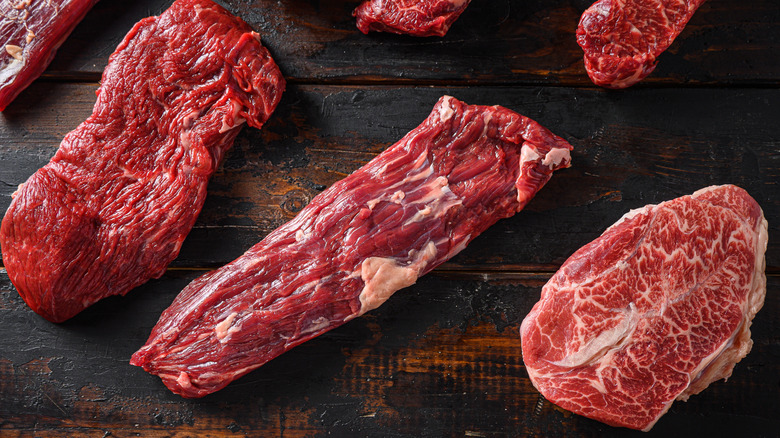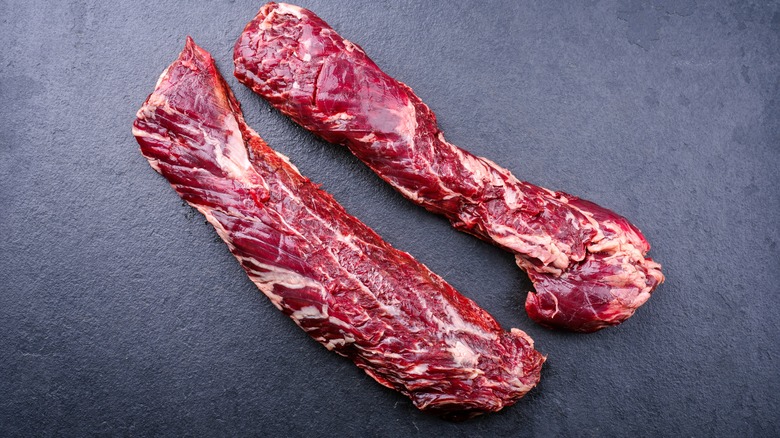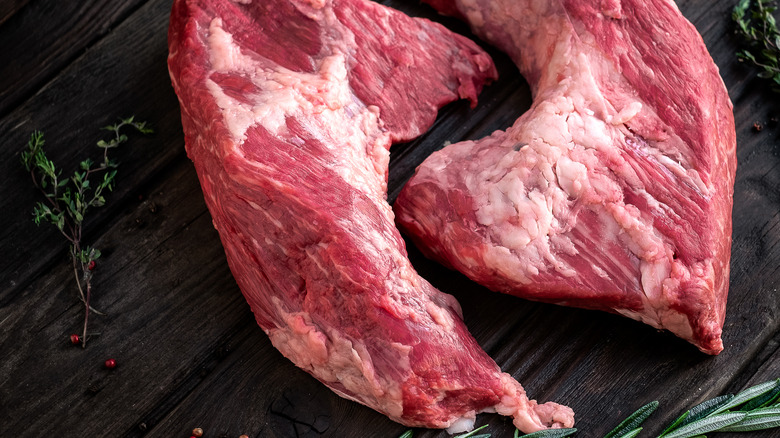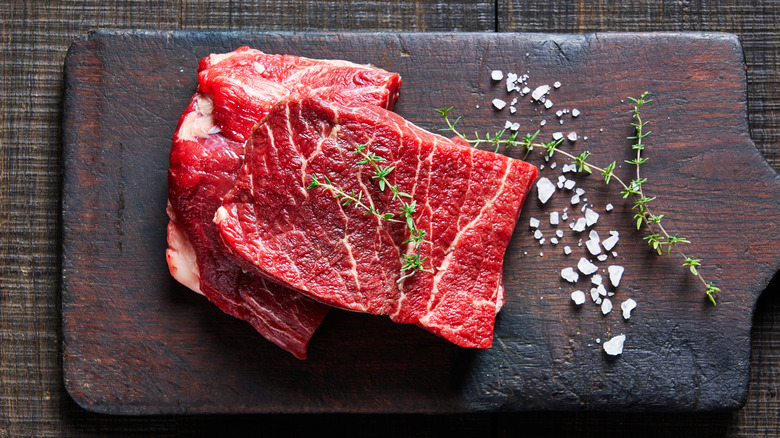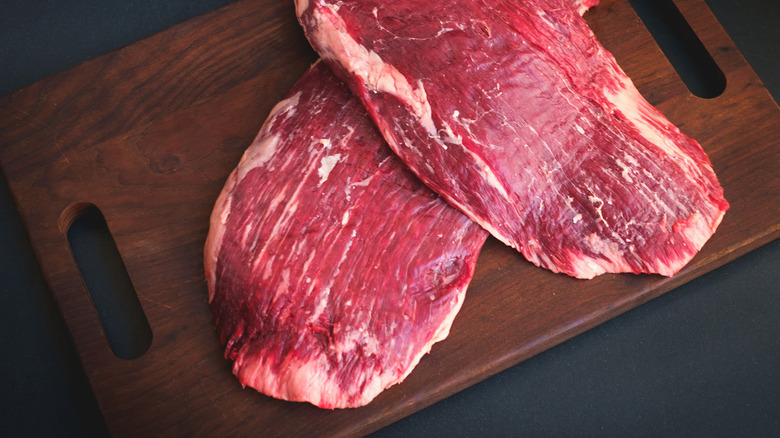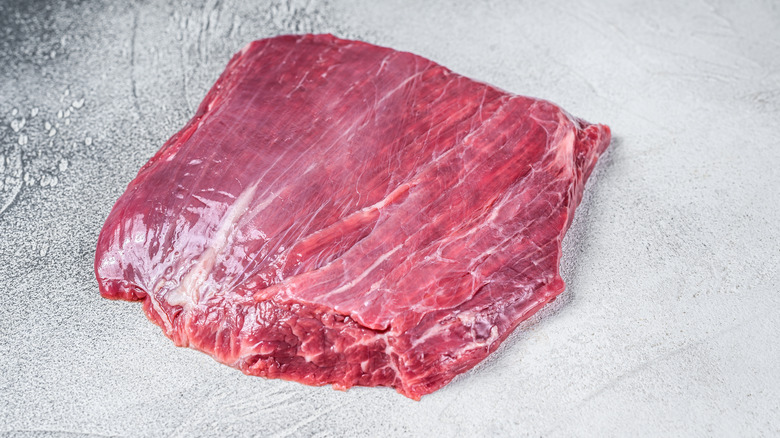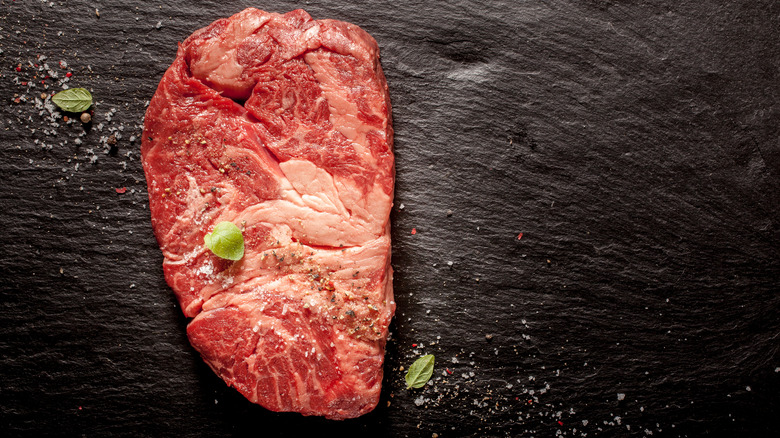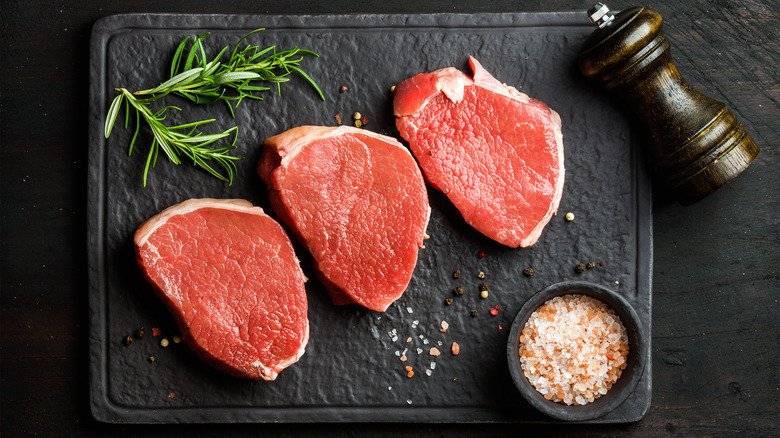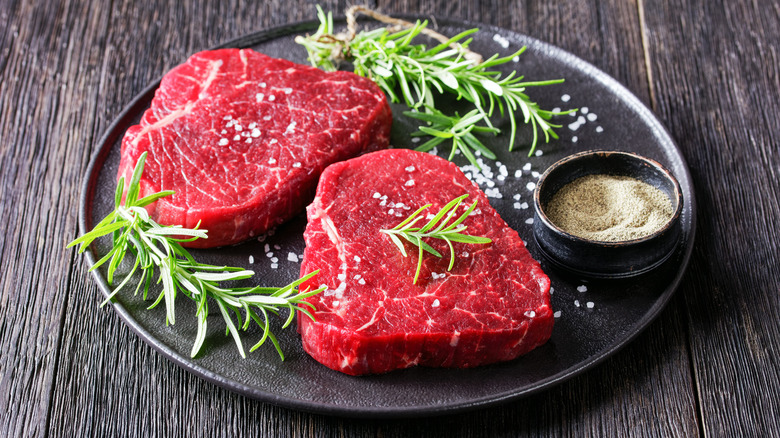12 Cuts Of Steak That Deserve More Attention
For the last couple of decades, the beef industry has been quietly changing, facing the rise of consumer awareness of sustainability challenges, followed by a decrease in cattle supply and soaring beef prices, with no signs of stopping any time soon. But, like with any change, there comes an opportunity. And in the case of beef, the search for a better way has opened our eyes to the fact there's more value in the beef carcass.
The truth is that high-flying steak cuts only account for 10%-12% of the animal but contribute one-third of its overall value. Thanks to collaborations between the industry and institutions such as Texas A&M and the Beef Checkoff Program, a significant portion of underutilized muscles have been identified in the past 10-15 years, giving rise to a new generation of beef cuts. Some have already built up a loyal following, like the flat iron steak, with many more in the pipeline.
Finally, the celebrated Wagyu beef is being met with humble opposition on the other side of the scale, and it's a flattering change for anyone in love with the good steak. New cuts we never heard of are put on display by the butchers around the country, offering the same great beefy flavors but for a fraction of the price. So which ones you should really pick? To help you navigate this newly emerging market of value beef cuts, we've rounded 12 less familiar steaks you need to start cooking with today.
1. Denver steak
Denver steak is a relatively new cut on the market. In 2008, meat science professors from the University of Florida and the University of Nebraska uncovered the tenderness of this cut as part of the Beef Checkoff Program (a program aimed to promote new, affordable cuts) — Denver steak was one of their hits, although, the name "Denver" has no actual significance.
Denver is located just under the shoulder blade in the chuck primal, where it gets less exercise. This means it is more tender and marbled than most tougher cuts from the chuck used for stews and roasts. It can be sold as a whole steak or cut into smaller pieces and has a deep, beefy flavor, similar to the flat iron steak. With Denver, you get a lot for your money — that is, if you can find it. There are only two Denver steaks per animal, so you may need to ask your butcher to order it for you or look for specialty stores online.
When buying a Denver steak, look for a bright red color, a good amount of white marbling, and a uniform thickness. Avoid steaks that are brown, dry, or unevenly cut. A simple seasoning of salt and pepper goes far and beyond with this cut, but if you have your favorite marinade or rub — there's no one to stop you. Remember to let your steak reach room temperature before cooking, and (always) rest it afterward.
2. Hanger steak
The hanger steak is a long cut of meat located under the cow's diaphragm between the rib and loin sections. Known by a variety of names worldwide, like onglet in France and lombatello in Italy, it is also called the butcher's steak, as butchers often reserved it for themselves. Comprising two muscles that form a V-shape, it's an incredibly tender cut despite an inedible membrane in the center.
While no longer a steal, hangers steak remains an affordable option. It usually yields about a pound and a half per cow, making it scarce and harder to find in supermarkets, but butchers typically have it. When buying a hanger steak from the butcher, look for a bright red piece with some marbling and no dark spots or bruises.
The hanger steak has a distinct, mineral-rich flavor and is more buttery than flank steak, thanks to its marbling. The best way to prepare the hanger steak is to marinate it and grill it whole over high heat for about 5 minutes per side. Let it rest and separate the two sides, discarding the membrane. If you do this right, it will literally melt in your mouth.
3. Tri-tip steak
Tri-tip steak is a lean, triangular-shaped cut from the tri-tip roast from the bottom sirloin. The tri-tip steak tastes full-bodied and beefy with a nice bite to it. The boneless roast is usually cut into one-inch-thick steaks, ready to be cooked right away.
Despite being a relatively lean cut, tri-tip has some marbling, which means it has enough white flecks of intramuscular fat to add buttery richness and flavor to the meat. Tri-tip steak thrives on quick cooking methods, such as grilling, broiling, or pan-searing, but if you like your steak a bit rare, it helps to marinate it beforehand. If you're using a grill, it shouldn't require more than 15 minutes to cook it for medium, less if you broil it.
When shopping for tri-tip, look for one-inch thick steaks with a decent amount of marbling. Avoid steaks that are too thin or too lean. However, finding tri-tip steak can be challenging, and it sometimes may go by different names. Try asking for alternatives like Santa Maria cut, bottom sirloin tip, or Newport steak if tri-tip does not bear any results.
4. Flat iron steak
The flat iron steak is a thin, rectangular cut of beef that comes from the shoulder or chuck of the cow. It is also known as the top-blade steak, the butler's steak, or the oyster-blade steak. The flat iron steak was only discovered in 2002 by two meat scientists in Nebraska looking for ways to use the tough and sinewy chuck. They found that by removing a thick band of connective tissue that runs through the middle of the top blade roast, they could create two flat steaks that resembled old-fashioned flat irons.
The flat iron steak is best cooked over high heat for a short time on a grill, skillet, or broiler. You want to sear the outside quickly to create a nice crust and lock in the juices, leaving the inside medium-rare to medium. It has a rich, beefy flavor and fine-grained texture, making it very tender and easy to chew. In fact, it is one of the most delicate and flavorful cuts of beef you can find, ranking second only to the filet mignon in tenderness.
When buying a flat iron steak from the butcher, first, you want to make sure that the connective tissue has been removed clean — you don't want any tough bits in your steak. Second, look for a steak that has a good amount of marbling throughout. This will give you more flavor and juiciness. Third, look for a steak with a bright red color and a firm texture.
5. Skirt steak
Skirt steak is a long, thin cut of beef that comes from the plate primal below the ribs of the cow. It has a rich, beefy taste and a coarse, fibrous texture, making it ideal for marinating and grilling. Skirt steak is sometimes called arrachera, fajita meat, or fajita steak and is similar to a flank steak, with both cuts often used interchangeably in recipes.
To cook a perfect skirt steak, you need a hot grill (or skillet), some oil, salt, and pepper. The beauty of it is that it's skinny and cooks up really fast — usually in just under 10 minutes. The trick is to sear it over high heat to form a beautiful crust, then give it a few minutes to rest before slicing it against the grain. Skirt steak makes for a speedy steak with eggs in the morning, or you can go the Mexican route and load your tortillas with it.
There are, in fact, two types of skirt steak: inside and outside. The outside skirt is thicker, more even, and tender, but you're unlikely to find it in a grocery store. Sadly, the restaurants are usually the first to snap it before it ever reaches the grocery store. So what you're left with is the inside skirt. To make the most of your steak, avoid overly thin or lean cuts, as they can become dry or tough after cooking.
6. Flank steak
Flank steak, or jiffy steak, is a cut of beef that comes from the abdominal muscles of the cow. It is long, thin, and has a distinct grain with a moderate chew. While it lacks the silky, fatty mouthfeel of heavily marbled cuts, flank steak leads the way with its robust and assertive beef flavor. It is also one of the leaner cuts of beef, with only 7 grams of fat per 3-ounce serving.
Look for a flank steak that's bright red and firm to the touch, with no signs of browning or sliminess. A decent flank steak should be about 1 inch thick and weigh between 1 and 2 pounds, with the grain running lengthwise. While it's true that flank steak has a lot of connective tissue and fibers that can make it dry and stringy, if cooked properly, it is one of the most rewarding (and undervalued) beef cuts.
One thing you can do to make it more juicy is to marinate your flank steak before cooking. You can use any marinade you like, as long as it is acidic — two hours or overnight in the refrigerator should be plenty to make it nice and tender. Next, you want to sear your flank steak for about 4 minutes per side: A medium-rare should feel soft but springy, while a medium should be firm but still have some give. Slice against the grain (always).
7. Sirloin Bavette steak
The sirloin bavette steak, bottom sirloin butt, or flap steak may not be well known, but it definitely deserves more attention. This unassuming cut is a thin, flat piece of beef from the bottom sirloin of the steer. It is similar to flank or skirt steak but has a thicker and meatier texture. The name "bavette" derives from the French word for bib, hinting at its thin appearance.
If not handled correctly, bavette can be tough. Tenderizing it with a meat hammer or marinating can do the trick. A dry rub made with coarse salt, sugar, and spices is perfect for barbecuing, while brining adds seasoning and keeps the meat juicy. When it's time to cook, aim for 3 to 4 minutes per side, depending on the thickness and how you like it done. Once cooked, be sure to slice it thinly against the grain and serve it with your favorite accompaniments — bavette really shines in sandwiches and tacos.
When buying bavette, look for dry-aged options, as they offer a deeper beef flavor. Opt for thicker cuts to prevent overcooking and ensure juiciness. The presence of marbling is a good sign, promising a nice buttery texture. Avoid cuts with too much fat or connective tissue, as they can affect the texture and flavor. You can also ask your butcher to trim any excess fat for you.
8. Chuck eye steak
Chuck eye steak, boneless chuck filet steak, or Delmonico steak is a cut of beef from the cow's upper shoulder, also known as the chuck primal. It is located next to the rib eye steak and is sometimes called the "poor man's rib eye" because it shares some of the same characteristics but for a fraction of the cost. It's like a less rich and fatty version of the rib eye.
Chuck eye steak has a beefy, buttery flavor with hints of nuttiness and sweetness. It's also very tender and juicy, with a lovely chewiness to it. To get the best out of your chuck eye steak, it's important to sear it at high temperature. Cook for 4 to 5 minutes per side for medium-rare, or if you prefer your steak well-done, add a few extra minutes per side, but be careful not to overcook it as this will make the meat tough.
At your butcher, ask for chuck eye steak by name and specify that you want it from the fifth rib. Look for a steak about 1 to 1.5 inches thick, with a good amount of marbling and fat. Avoid steaks that are too thin, lean, or dry. Check the color and smell of the steak: It should be bright red and have a clean, beefy smell.
9. Eye of round steak
The eye of round steak, also known as breakfast steak or wafer steak, is a thin, eye-like shaped slice taken from the cow's rear leg, or, to be more precise, the round primal. As it's located in a high-movement area, the meat tends to be more muscular and tougher than other cuts. However, this very characteristic is what makes it affordable. The eye of round steak is one of the most economical cuts of beef and one of the leanest.
The affordability of this humble cut should not be mistaken for a lack of quality. In fact, this modest cut really shines when prepared with care. To bring out its full potential, tenderizing the meat is absolutely critical. First, bash it with a mallet and marinate it for several hours (at least) or overnight in the fridge. You can grill it, but you have to be super careful not to overcook it — so, no blasting it with high heat. Cover the grill and cook it no higher than medium (throw some ash on coal if needed). A more foolproof way, however, would be to sear both sides and then braise it with some pan juices.
When buying eye of the round steak, look for a lean, well-trimmed cut. A good eye of round steak should be firm and have a rich red color. Although it's a very lean cut, it should still have visible thin streaks of fat running throughout the meat.
10. Round tip steak
The round tip, or sirloin tip steak, is a beef cut that comes from the round primal, located between the loin and the round. A whole piece typically weighs around 2½ pounds and can be sold as small steaks, cubes, or strips, with thickness ranging from ½ inch to 1½ inches. Since it's adjacent to the sirloin subprimal, the round tip is more tender than other round steaks.
For best results with this cut, you should definitely marinate or at least dry rub round-tip steak before cooking. Cook quickly over high heat to sear the outside and keep the inside juicy and pink, never past medium-rare, as it will become dry and tough. Cubed steak made from round tip meat works exceptionally well for kebabs. Similar to other sirloin cuts, sirloin tip steak boasts a rich, deep, beefy flavor and a distinguishible grain.
If you're hunting for round tip steak, keep an eye out for a bright red color and a firm, springy texture. Typically, this cut is sold untrimmed and features a thin layer of fat along the edge. If you stumble upon a "Sirloin Tip Center Steak" or a "Side Steak" label, go for it. These cuts will likely be the most tender. Steer clear of pre-cubed, as they may come from nearby hip and butt muscles.
11. Merlot steak
If you're a steak enthusiast, you've likely heard whispers about the merlot steak, a relatively new beef cut developed by The Beef Innovations Group (BIC). This cut is taken from the heel of the round, a lean and tough muscle typically used for ground beef or stew meat. However, the researchers isolated a portion of the muscle with a fine-grained texture and a rich, beefy flavor and named it merlot steak. While BIC didn't give a particular reason for that name, Terry Ragasa from Sutter Meats thinks it may be because "it's a finer cut, and you want to eat it with some wine," per HuffPost.
When it comes to preparing the merlot, simplicity is the key. It doesn't necessarily require tenderizing; a quick sear on both sides works wonders, with medium-rare being a sweet spot you shouldn't cross. Rest it for a brief five minutes before slicing, and remember to cut across the grain for optimal texture.
A merlot steak boasts tender, juicy meat and a rich, savory taste. Its sweetness is mild and understated, much like a sirloin, and it also has a subtle earthy flavor similar to flank steak. If you're purchasing this cut, pick a merlot steak that appears bright red and has a nice, firm texture.
12. Petite tender steak
The petite tender is yet another new cut out of the "Beef Value-Added Cuts" selection launched by the BIG. Also known as the bistro filet or teres mejor, this cut hails from the chuck primal, nestled in the shoulder of the cow. It is a rare find on the supermarket shelf, so the best idea would be to look for a specialist butcher; even then, you might need to preorder.
One of the signature features of this unique cut is one of the most tender steaks on the entire animal, trailing only behind the illustrious filet mignon or flat iron steak. Yet, it comes at a significantly friendlier price. It is also a very lean cut, with only 2 grams of fat per 3-ounce serving.
Petite tender embraces dry rubs and can be cooked whole or sliced into 1-2 inch medallions, just like the filet mignon. Due to its inherent tenderness, aim for a level of doneness between rare and medium; anything higher might lead to tough and dry steak. When buying the petite tender, choose a piece with a uniform size and shape, with a bright red color. It should be firm and spring back when pressed.
